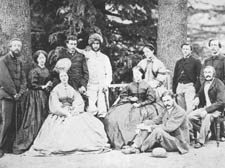|
|
 |
| |

The Sracheys and friends in Simla in the 1860s. Jane is seated left and Richard seated right. |
A family’s journey from Bombay to Bloomsbury
Piers Plowright reviews a biography of the diverse lives of the imperialist Strachey family
FROM BOMBAY TO BLOOMSBURY
by Barbara Caine,
Oxford University Press £12.99
THE cover photograph of this biography of the Strachey family, shows them as a late Victorian parody of a medieval tomb: father and mother facing each other, kneeling in prayer and the five sons and five daughters ranged behind them, boys to the left and girls to the right.
There’s only one famous face among them and that’s Lytton Strachey, minus beard and specs.
By the time you reach 1968 and the death of Pippa, the last of the daughters, you’ve been on a journey from high Victorian Imperialism to Modernism inside one complicated and sometimes infuriating family.
Who were the Stracheys and why do they matter? In 1858, Richard Strachey, one of a large legion of British administrators of the Indian Empire, married another one, Jane Grant, daughter of the secretary to the government of Bengal.
Richard, with his brother John, was a major influence on the development of India: its railways, laws, sanitation and civil government.
He devoted his life to it until his return to England in 1871, after which he became president of the Royal Geographic Society, a distinguished lecturer at Cambridge University, and a central figure in the establishment of Greenwich Observatory as the site of the Prime Meridian.
Richard’s wife, Jane, was a strong-minded woman, hot on women’s suffrage and female emancipation at home, without thinking any of it applied to the lives of Indian women.
They were classic imperialists and produced 14 children, of whom 10 survived. Jane remained a strong and energetic campaigner till her death in 1928, aged 88.
Of the five boys, Dick, Ralph and Oliver inherited the Indian legacy, without doing very well there (Oliver, however, had a late flowering as a code-breaker at Bletchley Park), while Lytton and James moved as far away as possible, Lytton into literature and James into psychoanalysis.
He and his wife became Freud’s first and favourite English translators.
Of the girls, Elinor, the oldest, was a devoted family woman, Dorothy married a French painter, taught, translated and wrote a novel, Olivia, which became a cult among lesbians in the 1940s.
Philippa (Pippa) took over the headship of the family and played a prominent part in the women’s movement, Pernel became Principal of Newnham College Cambridge, and Marjorie, turned into the most eccentric of an already eccentric family.
All of the children, with the exception of Lytton, lived into their 70s, three into their 80s, and Dorothy joined Pippa in getting within spitting distance of a century.
In a sense, the 12 figures on the ‘tomb’ are like a frieze joining Bengal with all its rigid traditions to the moody phenomenon of Bloomsbury.
Barbara Caine, Professor of History at Monash University, Australia, originally set out to write a study of the Strachey women, looking particularly at the development of feminism within it.
She soon realised that she couldn’t disentangle the women from the men and that studying the whole family could illustrate with great clarity, the shifts in the social, sexual, political, and literary landscape of the British middle classes between the Indian Mutiny and World War II.
She shows, for example, the movement from married orthodoxy – represented by Richard and Jane – and their first two children, Elinor and Dick, through promiscuity and divorce (Oliver), homosexuality (Lytton), and bisexuality (James).
She shows too how the sense of public duty modulated from imperial service to the championing of causes: feminism, sexual freedom, literary modernism, and how the position of the unmarried woman became less and less of a stigma, as women like Pernel and Pippa took charge of their own lives.
There’s even a nice symbolic geography to the family’s changes of address from India via Lancaster Gate and Belsize Park Gardens to Gordon Square. It’s a rich and many-layered tale.
Perhaps too rich. The need to sweep backwards and forwards, often over the same ground, as Caine applies yet another lens to the family history, can overload the reader.
But, with pauses for refreshment, and a long walk or two on Hampstead Heath, this is a rewarding book.
Another Bloomsburian, Leonard Woolf, wrote in his autobiography that the Stracheys were not only a remarkable family but also “an extinct phenomenon which has passed away and will never be known again”.
It’s good that they’ve found their chronicler.
|
 |
 |
|
 |
|


